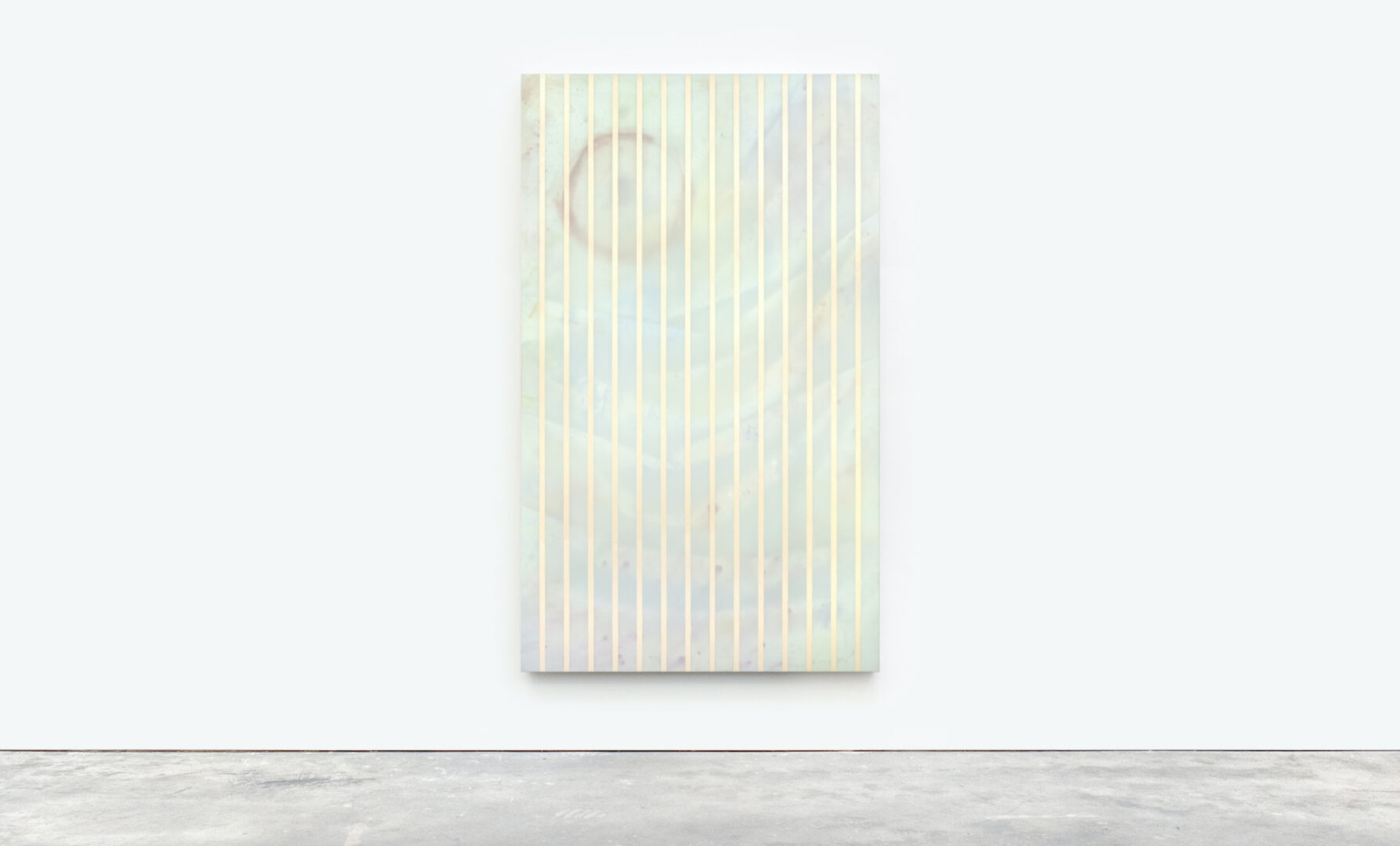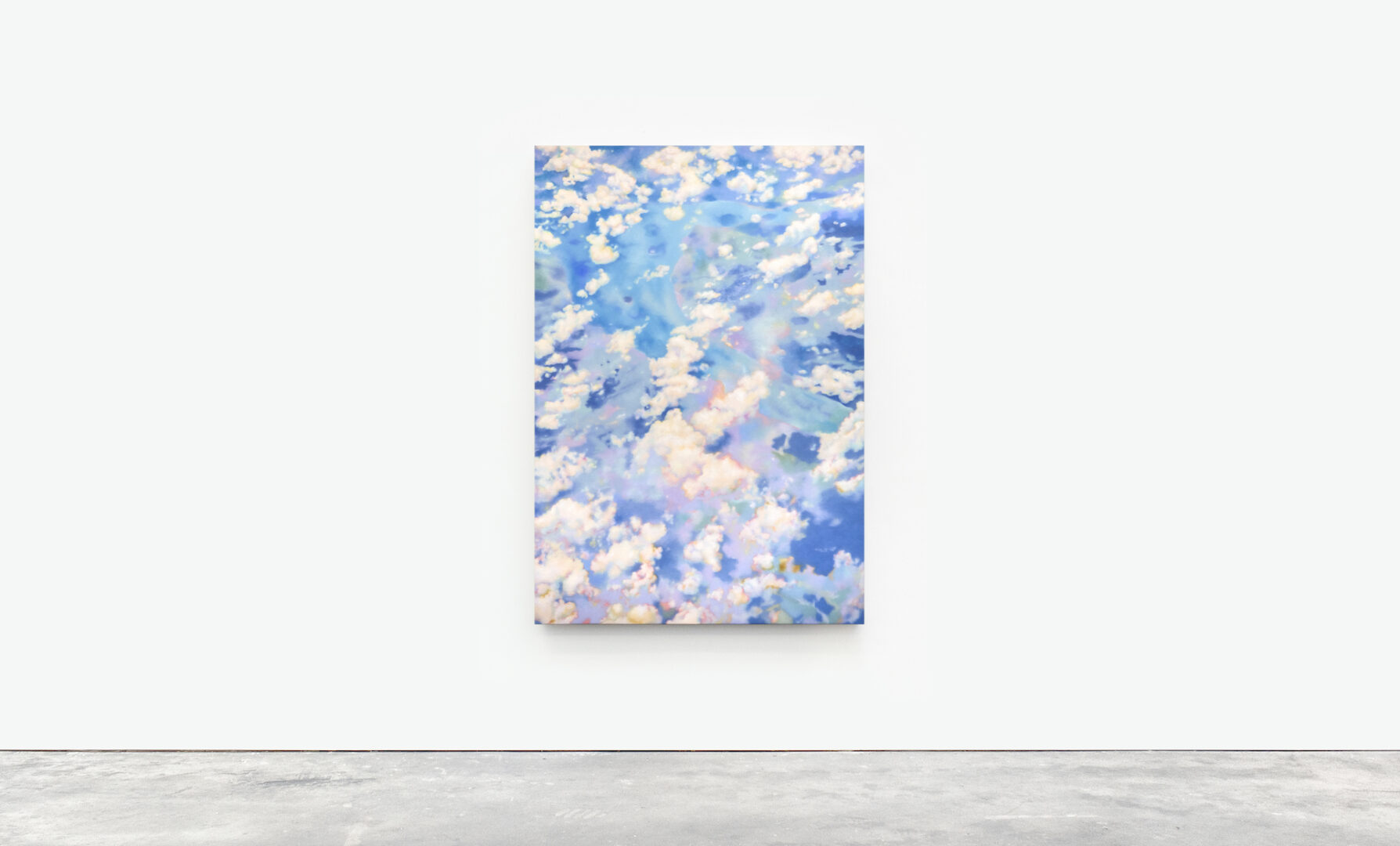Peering at the Edge of Daydream
Since interviewing the Norwegian artist Martine Poppe, I have been reflecting on her answers and also her well-known cloud paintings, which I first encountered a few years ago when the Kristin Hjellegjerde Gallery opened in Berlin Mitte (and which today form part of the UK Government Art Collection). Among the thoughts passing through my mind, I wondered how perception works on encountering something that first seems smooth, light, well, cloud-like and “easy”, but on hindsight contracts as through a needle’s eye into a very haptic world of dense matter informed by an “origin narrative that contains the smell of the sea and the restoration of polyester fabric”. You didn’t expect that, did you?
My musing led me to the concept of density expressed in the layers of meaning to be found in Poppe’s work, as in the case of her latest “happy loud in your face” flower depictions. They too can seem “easy” to look at but when you step closer you can sense an instant change in atmosphere – that is if you are willing to let yourself be consumed by them and see the decay appearing on the bright peach-colored petals (the image of a flower bouquet that has started to decompose on a fresh grave flashes before my inner eye).
These different stages of density mirror the fragments of the sharp-edged and melancholy writings of Irish poet and author Rosemarie Rowley that Poppe has woven into her work on show at the Kristin Hjellegjerde Gallery. In case you haven’t heard of Rosemarie Rowley, her “Sea of Affliction” published in 1987 is considered one of the first works of ecofeminism, so go read it! The exhibition’s title – “Peering at the Edge of Daydreams” – is borrowed from Rowley and illustrates Poppe’s ongoing interest in climate and ecofeminism, two issues that she lets clash ferociously “with the tropes of bubble-gum minimalism – vivid colors, flowers and sunshine.”
– Those who are willing to see know that art is truth.

Which of these elements (space, air, fire, water, earth) would you choose in relation to your practice and/or yourself, and why?
I’d probably have to go with air and water, seeing as I paint on polyester restoration fabric, which is more or less the same as sailcloth.
As a child, I spent a fair bit of time sailing and at the sailmaking factory my father ran with my uncle at Fornebu Marina by the Oslo fjord.
I think that’s why I became so interested in working with polyester restoration fabric in the first place – it’s a material I’ve been playing with since I was very young.
Also, I do paint a lot of clouds.
Image: Martine Poppe, Studio Portrait, 2020

Is there a particular person that inspired or influenced you to become an artist?
I’ve always loved making things with my hands. As a child, any type of art or craft interested me, from weaving and carpentry to painting and drawing, and becoming an artist was always on my mind.
However, over the years there’s been a lot of people that supported me, in particular my grandfather, and that makes a huge difference.
Sadly, my grandfather died before I began studying art, but I think that crisis in my life is part of what gave me the impetus to choose to become an artist, despite being aware of all the challenges that it might entail.


Do you consider yourself spiritual and how does this feed into your work?
I’m not sure if I’d consider it as being spiritual, but I’m in love with the fact that there are things that still remain mysterious to us, and I’m in awe of the intricacy and balance of the natural world. Over the past couple of years, I’ve been working from photographs of nature, such as clouds and flowers.
In that sense, nature has definitely had an impact on my work, not least because the current threat to the environment lends the subject a sense of urgency.


Is there an author you are reading or in general that inspires you?
Lately, I’ve been reading a fair bit of Rosemarie Rowley’s poems, and I’ve borrowed fragments of those poems for exhibition titles, both out of appreciation and to point to her work.



Please tell us what you are looking forward to this year!
Everything! In June I have a solo exhibition, The Earth in search of magic tidings, coming up with Kristin Hjellegjerde at Rekefabrikken (the Shrimp Factory) in Nevlunghavn in Norway. Architecturally Rekefabrikken is quite different than what I’m used to, and it carries with it a great deal of it’s own history.
The factory is a small wooden house, typical of the Scandinavian archipelago, and the local community would run the factory, bringing in the catch and processing it.

Like a lot of Norwegians, many of my ancestors worked at sea, and the familiarity and dependance on the ocean and marine life is still an important part of both the culture and the economy.
I’d like to connect with that in the upcoming show, using my participation the culture to talk about the issues associated with the direction that economic dependancy has taken in recent years.


Growing up I spent a lot of time sailing with my family around the Scandinavian archipelago, and preserving the environment that I grew up with is important to me.
I’m excited at the prospect and challenge of bringing some of my experiences and a bit of that innocence with me when making this show.

Where do you find inspiration, how can we imagine your process while creating work?
I start every show by taking photographs and processing them digitally, twisting the colours until the image is at the brink of dissolving.
The process gives me a starting point that motivates me to work further with the image through paint.
Once I begin painting, I only apply one layer of paint, and prefer to stay with the painting until it’s complete.
After that, the source photograph and other leftover materials, such as baby wipes and the textiles I cover my clothes with, are put to one side and later made into sculpture.
Martine Poppe, 2022, Detail, Peering at the edge of daydreams, oil on polyester restoration fabric, 160 x 110 cm
I work quite intensely towards my exhibitions, and during that process I usually have ideas that don’t fit with the body of work I’m making. Sometimes they pass, but when the ideas stick I develop them into new works and exhibitions.
In that sense, the inspiration for my work is something that grows organically from being fully involved with an ongoing process.


However, the works are executed with an abundance of control, the colours are twisted out of balance and the choice to use bouquets of flowers as a motif inevitably creates ties to memento mori painting, not to mention the fact that the production and export of cut flowers has a negative impact on the environment.

Aesthetics and Process aside, which emotions you want to trigger with your work and why?
I always want each person who looks at my work to have their own experience of it.
In that way, my aim is for the work to be a catalyst that lets the viewer have a moment to catch their breath, reflect and be outside themselves for a second.
Having said that, the works being shown in Berlin are louder, more descriptive and colourful than what I usually make.
That significantly changes how this show, Peering at the edge of daydreams, is experienced. In one way, it’s a nod to the fact that times have been hard for many, and I wanted to make something that can easily be considered as just joyous for those moments when it’s needed.
The joy is in the mix of processes and input, like including techniques like finger painting and choosing to work with flowers.
Martine Poppe, 2022, Silver, oil on polyester restoration fabric, 160 x 110 cm, 160 x 110 cm, oil on polyester restoration fabric
Simple pleasures aren’t necessarily so simple, and even something so innocent as a bouquet of flowers is a part of an economic system that exploits.

To me, looking closely at the paintings, they feel like an overly bright grin that doesn’t quite make it all the way to the eyes, and that’s also part of the journey that I want to take the viewer on.

If you could, what would you change in the art world/market?
First and foremost I’d magic up more funding for the arts on every level, from education and institutions to galleries and artists.
More funding would mean more space for diversity, experimentation, different outlooks and expressions.
In short, more funding would make the process of defining what art is and should be, more open, accessible and inclusive.

The future is .. ?
New, unwritten, daunting and exciting.
MARTINE POPPE – PEERING AT THE EDGE OF DAYDREAMS is on view till February 18th at Kristin Hjellegjerde Gallery, Berlin
Follow Martine on Instagram or find out more about her work on her website!
Intro: Esther Harrison
